
A transporter erector (TE) is a mobile system used to move rocket and launch vehicle systems while horizontal on the ground, and can provide the motive force to bring the vehicle vertical prior to final preparation for launch.

A transporter erector (TE) is a mobile system used to move rocket and launch vehicle systems while horizontal on the ground, and can provide the motive force to bring the vehicle vertical prior to final preparation for launch.
The United States Air Force's Minuteman ICBM weapon system uses a transporter erector as a mobile system to emplace LGM-30 Minuteman missiles inside their protective launch facilities.
SpaceX refers to their system for moving and erecting the Falcon 9 and Falcon Heavy vehicles as a TE.
The large Soviet N1 (rocket) used a transporter-erector for its 4 launch attempts.

The LGM-30 Minuteman is an American land-based intercontinental ballistic missile (ICBM) in service with the Air Force Global Strike Command. As of 2021, the LGM-30G Minuteman III version is the only land-based ICBM in service in the United States and represents the land leg of the U.S. nuclear triad, along with the Trident submarine-launched ballistic missile (SLBM) and nuclear weapons carried by long-range strategic bombers.

Vandenberg Space Force Base, previously Vandenberg Air Force Base, is a United States Space Force Base in Santa Barbara County, California. Established in 1941, Vandenberg Space Force Base is a space launch base, launching spacecraft from the Western Range, and also performs missile testing. The United States Space Force's Space Launch Delta 30 serves as the host delta for the base. In addition to its military space launch mission, Vandenberg Space Force Base also performs space launches for civil and commercial space entities, such as NASA and SpaceX.
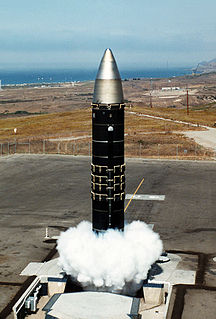
The LGM-118 Peacekeeper, originally known as the MX for "Missile, Experimental", was a MIRV-capable intercontinental ballistic missile (ICBM) produced and deployed by the United States from 1985 to 2005. The missile could carry up to twelve Mark 21 reentry vehicles, each armed with a 300-kiloton W87 warhead. Initial plans called for building and deploying 100 MX ICBMs, but budgetary concerns eliminated the final procurement; only 50 entered service. Disarmament treaties signed after the Peacekeeper's development led to its withdrawal from service in 2005.

A launch pad is an above-ground facility from which a rocket-powered missile or space vehicle is vertically launched. The term launch pad can be used to describe just the central launch platform, or the entire complex. The entire complex will include a launch mount or launch platform to physically support the vehicle, a service structure with umbilicals, and the infrastructure required to provide propellants, cryogenic fluids, electrical power, communications, telemetry, rocket assembly, payload processing, storage facilities for propellants and gases, equipment, access roads, and drainage.

The RT-2PM Topol is a mobile intercontinental ballistic missile designed in the Soviet Union and in service with Russia's Strategic Missile Troops. As of 2014, Russia planned to replace all SS-25 ICBMs with versions of Topol-M.
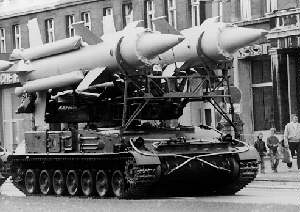
A transporter erector launcher (TEL) is a missile vehicle with an integrated tractor unit that can carry, elevate to firing position and launch one or more missiles.
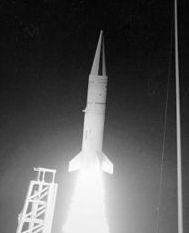
Aries is an American sounding rocket and target rocket, developed by Space Vector Corporation from retired LGM-30 Minuteman I intercontinental ballistic missile (ICBM) stages for use by the United States Air Force and NASA. Taken over by Orbital Sciences Corporation, Aries, as the Target Test Vehicle, remains in use.

Launch Complex 39 (LC-39) is a rocket launch site at the John F. Kennedy Space Center on Merritt Island in Florida, United States. The site and its collection of facilities were originally built as the Apollo program's "Moonport" and later modified for the Space Shuttle program.
In terms of rocketry, Ares could mean:
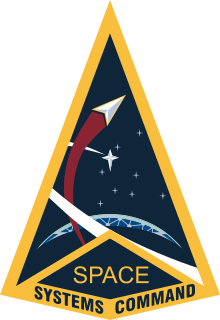
Space Systems Command (SSC) is the United States Space Force's space development, acquisition, launch, and logistics field command. It is headquartered at Los Angeles Air Force Base, California and manages the United States' space launch ranges.

Minotaur II rockets consist of the M55A1 first stage and SR19AJ1 second stage of a decommissioned Minuteman missile. The third stage varies depending on the configuration required for the payload: a Minuteman II M57A1 stage is used on the baseline configuration, whilst the Minotaur II+ uses an SR-73-AJ. The Minotaur II Lite is a two-stage configuration, without a third stage. A heavy configuration is also available, with an Orion 50XL third stage, as used on the Minotaur I. The baseline configuration can propel a 400 kilograms (880 lb) payload 4,000 kilometres (2,500 mi) downrange, whilst the heavy configuration can place 1,400 kilograms (3,100 lb) onto a 8,000-kilometre (5,000 mi) trajectory.
This is a chronology of the LGM-30 Minuteman intercontinental ballistic missile, acquisition and operational.
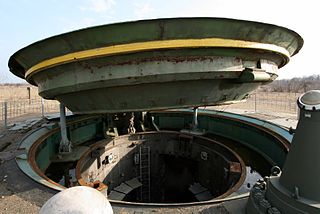
A missile launch facility, also known as an underground missile silo, launch facility (LF), or nuclear silo, is a vertical cylindrical structure constructed underground, for the storage and launching of intercontinental ballistic missiles (ICBMs), intermediate-range ballistic missiles (IRBMs), medium-range ballistic missiles (MRBMs). Similar facilities can be used for anti-ballistic missiles (ABMs).

The Peacekeeper Rail Garrison was a railcar-launched ICBM that was developed by the United States Air Force during the 1980s as part of a plan to place fifty MGM-118A Peacekeeper intercontinental ballistic missiles on the rail network of the United States. The railcars were intended, in case of increased threat of nuclear war, to be deployed onto the nation's rail network to avoid being destroyed by a first strike counterforce attack by the Soviet Union. However, the plan was canceled as part of defense cutbacks following the end of the Cold War, and the Peacekeeper missiles were installed in silo launchers as LGM-118s instead.
The ZBGM-75 Advanced Intercontinental Ballistic Missile, also known as Weapons System 120A (WS-120A), was a program to develop an intercontinental ballistic missile (ICBM), proposed by the United States Air Force in the 1960s as a replacement for the LGM-30 Minuteman as the Air Force's standard ICBM. Funding was not allocated for the program and the project was cancelled in 1967.

The 6555th Aerospace Test Group is an inactive United States Air Force unit. It was last assigned to the Eastern Space and Missile Center and stationed at Patrick Air Force Base, Florida. It was inactivated on 1 October 1990.

In the military, vehicles such as trucks or tractor units can be used to transport or launch missiles, essentially a form of rocket artillery.
A Minuteman Mobility Test Train was a Cold War train for Strategic Air Command testing before deployment of planned trains for launching Minuteman missiles which were to allow periodic movement for security from targeting by the Soviet missile force. At the time, the trains had the heaviest railroad cars used on regular rail routes, and rail sidings were surveyed during the trains' 1960 Operation Big Star